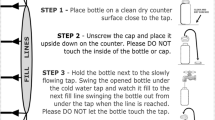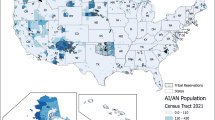Abstract
Background
In 2015 alone, community water systems serving about 21 million Americans violated the United States Environmental Protection Agency’s (US-EPA) water quality standards. While water at community treatment and distribution centers is regularly monitored and tested, little is known about pollutants in the water systems at the household level.
Aims
This pilot study assessed the feasibility of (1) testing for the presence and concentration of 14 contaminants and physicochemical parameters in household tap water in a low-income neighborhood and (2) using community engagement for recruitment and citizen science approaches to data collection.
Methods
We used a multistage approach that included geo-mapping to delineate testing sites, community engagement for recruitment and citizen science approaches to increase the response rate. We used a 14-in-one dipstick test designed to measure trace amounts of heavy metals, non-metallic elements, and physicochemical water properties in drinking water in a sample of 70 homes.
Results
In 50%, 25%, and 7% of water samples tested, the concentration of mercury, lead, and chromium, respectively, were higher than US-EPA drinking water standards. Citizen science approaches were effective for increasing response rates and low-income household participation in water quality testing.
Significance
The overlap between poverty, older homes, and high concentrations of potentially toxic metals in drinking water presents concerns for community health. Our pilot community engagement and citizen science approaches are likely scalable and would be of benefit to both the scientific community and to municipalities with constrained budgets. Future studies may examine the role of the principles of environmental justice in the distribution and prevalence of toxic elements in drinking water.
This is a preview of subscription content, access via your institution
Access options
Subscribe to this journal
Receive 6 print issues and online access
$259.00 per year
only $43.17 per issue
Buy this article
- Purchase on Springer Link
- Instant access to full article PDF
Prices may be subject to local taxes which are calculated during checkout



Similar content being viewed by others
References
Allaire M, Wu H, Lall U. National trends in drinking water quality violations. Proc Natl Acad Sci USA. 2018;115:2078–83. https://www.pnas.org/content/115/9/2078
Zhang D, Bond T, Krasner SW, Chu W, Pan Y, Xu B, et al. Trace determination and occurrence of eight chlorophenylacetonitriles: an emerging class of aromatic nitrogenous disinfection byproducts in drinking water. Chemosphere. 2019;220:858–65.
Hopkins ZR, Sun M, DeWitt JC, Knappe DRU. Recently detected drinking water contaminants: genx and other per- and polyfluoroalkyl ether acids. J Am Water Works Assoc. 2018;110:13–28. https://doi.org/10.1002/awwa.1073
Elliott EG, Ma X, Leaderer BP, McKay LA, Pedersen CJ, Wang C, et al. A community-based evaluation of proximity to unconventional oil and gas wells, drinking water contaminants, and health symptoms in Ohio. Environ Res. 2018;167:550–7.
Evans S, Campbell C, Naidenko OV. Cumulative risk analysis of carcinogenic contaminants in United States drinking water. Heliyon. 2019;5:e02314
Harvey PJ, Handley HK, Taylor MP. Widespread copper and lead contamination of household drinking water, New South Wales, Australia. Environ Res. 2016;151:275–85.
United States Environmental Protection Agency. Safe Drinking Water Act (SDWA) and Federal Facilities. 2017 [cited 2020 Oct 1]. Available from: https://www.epa.gov/enforcement/safe-drinking-water-act-sdwa-and-federal-facilities
Marshall AT, Betts S, Kan EC, McConnell R, Lanphear BP, Sowell ER. Association of lead-exposure risk and family income with childhood brain outcomes. Nat Med. 2020;26(Jan):91–7. https://doi.org/10.1038/s41591-019-0713-y
Tchounwou PB, Yedjou CG, Patlolla AK, Sutton DJ. Heavy metal toxicity and the environment. Vol. 101, Experientia supplementum. NIH Public Access; 2012 [cited 2020 Oct 1]. 133–64. Available from: /pmc/articles/PMC4144270/?report=abstract
Trocello JM, Broussolle E, Girardot-Tinant N, Pelosse M, Lachaux A, Lloyd C, et al. Wilson’s disease, 100 years later. Vol. 169, Revue Neurologique. Elsevier Masson; 2013. 936–43.
Morton MS, Elwood PC, Abernethy M. Trace elements in water and congenital malformations of the central nervous system in South Wales. Br J Prev Soc Med. 1976;30:36–9. http://jech.bmj.com/
Grazuleviciene R. Effects of elevated levels of manganese and iron in drinking water on birth outcomes. Pol J Environ Stud 2009;18:819–25. http://www.pjoes.com/Effects-of-Elevated-Levels-of-Manganese-and-Iron-r-nin-Drinking-Water-on-Birth-Outcomes,88299,0,2.html
Chowdhury S, Mazumder MAJ, Al-Attas O, Husain T. Heavy metals in drinking water: occurrences, implications, and future needs in developing countries. Vols. 569-70, Science of the Total Environment. Elsevier B.V.; 2016. p. 476–88.
Brown M, Margolis S. Morbidity and mortality weekly report lead in drinking water and human blood lead levels in the United States. 2012 [cited 2020 Oct 1]. Available from: https://stacks.cdc.gov/view/cdc/27409
Henriques MC, Loureiro S, Fardilha M, Herdeiro MT. Exposure to mercury and human reproductive health: A systematic review. Vol. 85, Reproductive Toxicology. Elsevier Inc.; 2019. p. 93–103.
Zahir F, Rizwi SJ, Haq SK, Khan RH. Low dose mercury toxicity and human health. Environ Toxicol Pharmacol. 2005;20:351–60.
Bose-O’Reilly S, McCarty KM, Steckling N, Lettmeier B Mercury exposure and children’s health. Vol. 40, Current Problems in Pediatric and Adolescent Health Care. Mosby Inc.; 2010. 186–215.
Uriu-Adams JY, Keen CL. Copper, oxidative stress, and human health. Vol. 26, Molecular Aspects of Medicine. Pergamon; 2005. p. 268–98.
He X, Li P. Surface water pollution in the middle chinese loess plateau with special focus on hexavalent chromium (Cr6+): occurrence, sources and health risks. Expo Heal. 2020;12:385–401. https://doi.org/10.1007/s12403-020-00344-x.
Tseng CH, Lee IH, Chen YC. Evaluation of hexavalent chromium concentration in water and its health risk with a system dynamics model. Sci Total Environ. 2019;669:103–11.
Stene LC, Hongve D, Magnus P, Ronningen KS, Joner G. Acidic drinking water and risk of childhood-onset type 1 diabetes. Diabetes Care. 2002;25:1534–8. https://care.diabetesjournals.org/content/25/9/1534
Aschencrau A, Zierler S, Cohen A. Quality of community drinking water and the occurrence of spontaneous abortion. Arch Environ Health. 1989;44:283–90. https://doi.org/10.1080/00039896.1989.9935895.
Stillo F, Gibson JM. Exposure to contaminated drinking water and health disparities in North Carolina. Am J Public Health. 2017;107:180–5. https://doi.org/10.2105/AJPH.2016.303482.
Sanders AP, Desrosiers TA, Warren JL, Herring AH, Enright D, Olshan AF, et al. Association between arsenic, cadmium, manganese, and lead levels in private wells and birth defects prevalence in North Carolina: a semi-ecologic study. BMC Public Health. 2014;14:1–2.
Holdren J. Addressing societal and scientific challenges through citizen science and crowdsourcing. Memorandum to the heads of executive departments and agencies: Addressing societal and scientific challenges through citizen science and crowdsourcing. White House Of. 2015.
European Commission. Open Innovation, Open Science, Open to the World––A vision for Europe. Luxembourg: Publications Office of the European Union. 2016. 54.
Hecker S, Haklay M, Bowser A, Makuch Z, Vogel JE. Citizen science: innovation in open science, society and policy. Hecker S, Haklay M, Bowser A, Makuch ZVJ, editors. UCL Press; 2018. p. 83.
Baldwin Meadows. 14-in-1 Drinking Water Test Kit – Low Level Detection for Lead, Fluoride, Iron, Copper & Mercury. Baldwin, Maryland, USA.
Bound JP, Harvey PW, Francis BJ, Awwad F, Gatrell AC. Involvement of deprivation and environmental lead in neural tube defects: a matched case-control study. Arch Dis Child. 1997;76:107–12. http://adc.bmj.com/
Brender JD, Suarez L, Felkner M, Gilani Z, Stinchcomb D, Moody K, et al. Maternal exposure to arsenic, cadmium, lead, and mercury and neural tube defects in offspring. Environ Res. 2006;101:132–9.
Callan AC, Hinwood AL, Ramalingam M, Boyce M, Heyworth J, McCafferty P, et al. Maternal exposure to metals-Concentrations and predictors of exposure. Environ Res. 2013;126:111–7.
Dolk H, Vrijheid M The impact of environmental pollution on congenital anomalies. Vol. 68, British Medical Bulletin. Oxford Academic; 2003 [cited 2020 Oct 1]. 25–45. Available from: https://academic.oup.com/bmb/article/68/1/25/421227
Salehi M, Abouali M, Wang M, Zhou Z, Nejadhashemi AP, Mitchell J, et al. Case study: fixture water use and drinking water quality in a new residential green building. Chemosphere. 2018;195:80–9.
Chowdhury S, Kabir F, Mazumder MAJ, Zahir MH. Modeling lead concentration in drinking water of residential plumbing pipes and hot water tanks. Sci Total Environ. 2018;635:35–44.
Jarvis P, Quy K, Macadam J, Edwards M, Smith M. Intake of lead (Pb) from tap water of homes with leaded and low lead plumbing systems. Sci Total Environ. 2018;644:1346–56.
Redmon JH, Levine KE, Aceituno AM, Litzenberger K, Gibson JMD. Lead in drinking water at North Carolina childcare centers: Piloting a citizen science-based testing strategy. Environ Res. 2020;183:109126.
Maccani G, Goossensen M, Righi V, Creus J, Balestrini M. Scaling up Citizen Science What are the factors associated with increased reach and how to lever them to achieve impact. 2020 [cited 2021 Apr 29]; Available from: https://ec.europa.eu/jrc
Pocock MJO, Roy HE, August T, Kuria A, Barasa F, Bett J, et al. Developing the global potential of citizen science: Assessing opportunities that benefit people, society and the environment in East Africa. McKenzie A, editor. J Appl Ecol. 2019 Feb [cited 2021 Apr 29];56:274–81. Available from: https://doi.org/10.1111/1365-2664.13279
Odunitan-Wayas FA, Hamann N, Sinyanya NA, King AC, Banchoff A, Winter SJ, et al. A citizen science approach to determine perceived barriers and promoters of physical activity in a low-income South African community. Glob Public Health. 2020;15:749–62. https://doi.org/10.1080/17441692.2020.1712449.
Den Broeder L, Lemmens L, Uysal S, Kauw K, Weekenborg J, Schönenberger M, et al. Public health citizen science; perceived impacts on citizen scientists: a case study in a low-income neighbourhood in the Netherlands. Citizen Sci Theory Pract. 2017;2:1–17.
Carrera J, Key K, Bailey S, Hamm J, Cuthbertson C, Lewis E, et al. Community science as a pathway for resilience in response to a public health crisis in Flint, Michigan. Soc Sci. 2019;8:94 https://www.mdpi.com/2076-0760/8/3/94
Tyler G, Yvon JICP-OES, ICP-MS and AAS Techniques Compared. researchgate.net. 1995 [cited 2020 Oct 1]. Available from: https://www.researchgate.net/file.PostFileLoader.html?id=598360453d7f4bcbdb0de094&assetKey=AS%3A523326150725632%401501782085752
Quinlivan L, Chapman DV, Sullivan T. Validating citizen science monitoring of ambient water quality for the United Nations sustainable development goals. Sci Total Environ. 2020;699:134255.
United States Environmental Protection Agency. Learn About Environmental Justice. 2017 [cited 2020 Oct 1]. Available from: https://www.epa.gov/environmentaljustice/learn-about-environmental-justice
Browning CR, Cagney KA, Boettner B. Neighborhood, place, and the life course. In Handbook of the life course; Springer, Cham. 2016, pp. 597–620.
Principles of environmental justice. [cited 2020 Oct 1]. Available from: https://www.ejnet.org/ej/principles.html
United States Environmental Protection Agency. Drinking Water: What are the trends in the quality of drinking water and their effects on human health?. 2018 [cited 2020 Oct 1]. Available from: https://www.epa.gov/report-environment/drinking-water
Balazs CL, Ray I. The drinking water disparities framework: on the origins and persistence of inequities in exposure. Am J Public Health. 2014;104:603–11. https://doi.org/10.2105/AJPH.2013.301664.
Acknowledgements
We would like to thank all study participants and research team members. We would also like to thank the University of North Carolina’s Child and Family Research Network (CFRN) for supporting this project.
Funding
This pilot study was funded by the University of North Carolina’s Child and Family Research Network (CFRN). CFRN supported the Project Coordinators, the costs of collecting water samples, testing the water samples, and providing filters to families whose tap water indicated potentially harmful contaminants and characteristics.
Author information
Authors and Affiliations
Contributions
LO co-designed the work that led to manuscript submission, collected the data, interpreted the results, and drafted the manuscript. SS conceived the work that led to submission and played an important role in acquiring and interpreting the data. SM conceived the work that led to submission and played an important role in interpreting the results. All authors read and made revisions to the article and are accountable for all aspects of the work.
Corresponding author
Ethics declarations
COMPETING INTERESTS
The authors declare no competing interests.
Additional information
Publisher’s note Springer Nature remains neutral with regard to jurisdictional claims in published maps and institutional affiliations.
Supplementary information
Rights and permissions
About this article
Cite this article
Odetola, L., Sills, S. & Morrison, S. A pilot study on the feasibility of testing residential tap water in North Carolina: implications for environmental justice and health. J Expo Sci Environ Epidemiol 31, 972–978 (2021). https://doi.org/10.1038/s41370-021-00352-2
Received:
Revised:
Accepted:
Published:
Issue Date:
DOI: https://doi.org/10.1038/s41370-021-00352-2
This article is cited by
-
Methods in Public Health Environmental Justice Research: a Scoping Review from 2018 to 2021
Current Environmental Health Reports (2023)
-
Health and Environmental Protective Behavioral Intentions for Reducing Harm from Water Pollutants
Environmental Management (2023)



